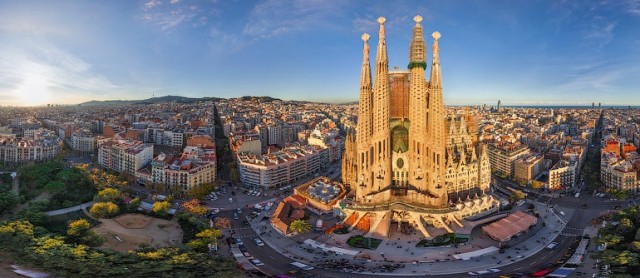Barcelona
BARCELONA IS THE second-largest city in SPAIN after MADRID and is the capital of the autonomous region of Catalunya/Cataluna (Catalonia), which is situated in the northeast of Spain. The region is bordered to the north by the PYRENEES mountain range, which acts as a natural border between Spain, ANDORRA, and FRANCE; to the east the region is bordered by the MEDITERRANEAN SEA; to the west by the region of Aragon; and to the south by the Valencia region.
The metropolitan area of Barcelona has a population of approximately 3 million citizens, although only about 1.6 million of this total reside within the bounds of the city proper. The city comprises a number of distinct districts, each with its own character and urban form, which includes Cuitat Vella, the old city area, the 19th-century Eixample/Ensanche (extension), Montjuic, Sarria, Gracia, and new districts (Nou Barris) such as Trinitat Nova at the city periphery. As a consequence of these different districts, it is possible to walk by Roman remains, medieval buildings, and modern developments within a short space of time, particularly if walking westward from the low-lying seafront areas such as Barcelonetta or Barri Gotic (Gothic district) to the hills surrounding the city.

Like many other settlements in Spain and Europe, Barcelona has a long history, and the Romans were significant to its early development. Today, the outline of the Roman Forum can still be seen in the center of the city, and parts of the city walls built by the Romans also remain. During its history the city has been controlled and fought over by a number of different peoples, including the Visigoths in the 5th century, the Frankish Kings of the 9th century, and the Muslim statesman Al-Mansur in 985. The golden age of Barcelona as an economic and cultural power, however, dates from the late 19th century, although its development was late when compared with other European cities in England and France.
Nonetheless, upon the tearing down of the medieval city walls in the mid-19th century, the city for the first time was able to develop at a rate never seen before in its history. But this removal of the city walls was in part necessary because of the cramped, diseaseridden conditions of the old city and the fact that the lack of space also hindered its growing industrial base. Therefore, with the removal of the city walls, Barcelona was able to spatially, economically, and culturally expand itself, and this legacy comprises vast sways of the city's urban form today.
For example, the huge district known as Eixample, laid down to a plan by Ildefons Cerda (1815–76), not only transformed the old settlement but remains a major element of the modern city today. Characterized by its geometrically formed grid crossed by wide avenues, the Eixample was a pioneering urban project within which considerations were made for traffic circulation, sunlight, and ventilation in the houses built within square-shaped blocks (the corners of which are rounded).
Within this large district are found many of the city's most beautiful buildings as well, including numerous edifices by renowned architect Antonio Gaudi who designed largely in Gothic inspired and an art nouveau style. Among the most prominent of Gaudi's works in the Eixample are the Casa Batllo, Casa Mila (La Pedrera, the “quarry”), and La Sagrada Familia (The Holy Family, from 1884), probably the city's most famous symbol after its football team, Barcelona Football Club. Gaudi's legacy in the city today forms an integral part of the city's tourist industry, and tourists from all over the world come to the city to marvel at his work and also the city's rich culture, which includes museums of the modern artist Joan Miro and the father of cubism, Pablo Picasso.
In recent times, Barcelona has become synonymous with international sporting and cultural events, such as the 1992 Summer Olympics and the 2004 International Forum of Cultures, and many people see these events as integral elements in the development of the city and its economy. In reality, Barcelona has a tradition of hosting famous events that dates from 1888, when it held the Universal Exposition; this tradition was continued into the 1920s with the World's Fair, an event in which Ludwig Mies van der Rohe helped develop modernist architecture through the design of his Pavilion building. Nonetheless, these events have helped architecturally, economically, and culturally shape the city and its urban form, the result of which is a vibrant, cosmopolitan center today that inspires both eye and mind.